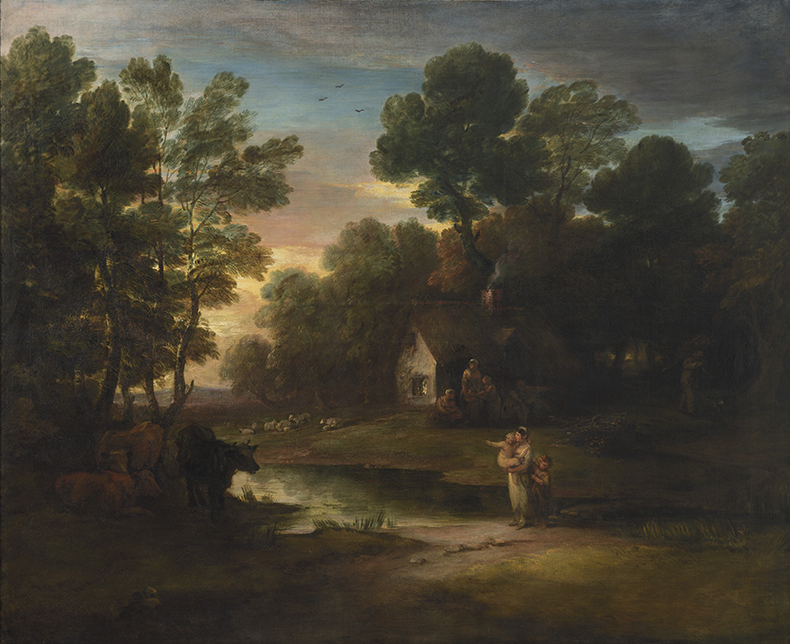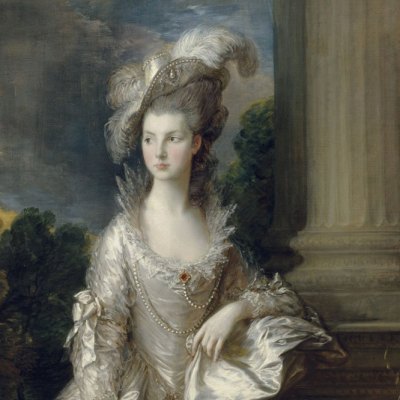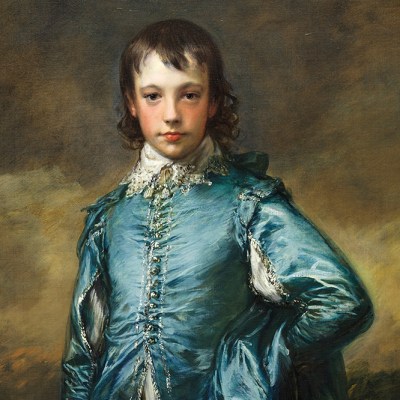From the January 2023 issue of Apollo. Preview and subscribe here.
The houses of artists and writers can be works of art in themselves, bristling with the evidence of their creators’ passions. Frederic Leighton’s recently reopened studio house is one such, and so is Walter Scott’s Abbotsford. Others, in which few if any objects survive to connect them with their illustrious former residents, must ask their visitors something more challenging: to tune into the atmosphere of a place and to imagine a creative human presence. Thomas Gainsborough’s childhood home in Sudbury falls into the second category – it is an unavoidable fact that he only lived in the house until he was around 13 – and yet merely in travelling there many visitors’ imaginations will already be primed. John Constable once said he fancied he saw Gainsborough in every hedge and hollow tree, and I know what he means. As a young man Gainsborough compulsively sketched Suffolk’s woods, sandy banks, paths, tree stumps, stiles and cattle-watering pools, all of which found their way into his paintings. To travel towards Sudbury is to be plunged into Gainsborough World, although I can never decide whether the foliage of the region’s trees really does have a greenish-grey, feathery appearance or whether I have unwittingly absorbed Gainsborough’s pictures to the extent that I am incapable of seeing this corner of Suffolk without this aesthetic filter.
The director of Gainsborough’s House, Mark Bills, wants visitors to feel a sense of place. He points to the bricks of the striking new building that has been constructed behind the house, on the site of a disused council building: handmade, he says, just a few miles outside Sudbury. On the top floor, in the Landscape Studio, Bills gestures towards another connection to the surrounding land. Look out of the floor-to-ceiling windows, over Sudbury’s rooftops to the hills beyond: there is the setting for the early double portrait of Robert Andrews, who had been a fellow pupil at Gainsborough’s grammar school, and his young wife Frances (c. 1750), which now hangs in the National Gallery. The new space, which also houses a camera obscura, opens an eye on to the surrounding countryside, so potent a source of inspiration for Gainsborough, and forges a powerful connection with it. Though a brand new building, the gallery feels as rooted in its spot behind the house as the ancient mulberry tree in the garden.
The house in Sudbury where Gainsborough was born and lived until around 1740, when he was 13 year old, became a museum in 1961. Photo: Hufton + Crow

Like so many Suffolk town houses, the Gainsborough family home has late medieval origins; in 1723, four years before the artist’s birth, his parents disguised these with a smart brick facade, a lasting testament to their ownership. This ‘most excellent Brickt Mansion’, as the auctioneers put it, was finally sold in 1792, four years after Thomas’s death. Although no furniture or decorative schemes remain from the house’s lengthy period in the family’s hands, there is one intriguing survival. In 1966, five years after the house museum opened, a stash of paint bladders was discovered in the attic, of the kind used by artists in the 18th and early 19th centuries before paint began to be stored in metal tubes. Could they have belonged to Gainsborough himself, stored there during one of his moves and afterwards forgotten? These intriguing objects, like shrivelled toffee apples, are on display in the Painting Room. Added to the house in the Regency period, this north-facing space is now devoted to the nuts and bolts of picture-making. A printing press stands in the centre and a painting on an easel. There are etching plates, paint boxes, palettes, brushes and knives, a lay figure sprawled on a chair and plaster casts balanced on shelves. On the wall are Gainsborough’s copies after two of his artistic heroes, Peter Paul Rubens and Anthony Van Dyck, along with The Pitminster Boy (c. 1768–69), a portrait of a young studio assistant anxiously proffering a paint brush.
After the engaging paraphernalia of the Painting Room, the Parlour next door strikes a politer note, evoking a mid 18th-century reception room, with a central table, set for tea, surrounded by portraits that offer a glimpse of Gainsborough’s family background and early Suffolk years. His love of landscape is hinted at with pictures of the kind he would later call ‘imitations of little Dutch landskips’. In these wooded scenes, he spliced the Suffolk scenery he knew so well with what he had learned from studying the country lanes, gnarled old trees and cloudy skies of 17th-century Dutch artists such as Jacob van Ruisdael, Jan Wijnants and Meindert Hobbema.
A recreation of an 18th-century painting room at Gainsborough’s House. Photo: © Hufton + Crow

Another room explores Gainsborough’s passion for music through period instruments, from a cittern to a double-manual harpsichord, shown alongside portraits that include his friend Johann Christian Bach and the musician Ann Ford posing with her English guitar (a study for the painting in Cincinnati). For the artist, music-making was a convivial business. ‘Gainsborough’s profession,’ said another composer friend, William Jackson, represented here in a portrait by John Downman, ‘was painting, and music his amusement; yet, there were times when music seemed to be his employment and painting his diversion.’ Bills and his curatorial team have skilfully presented these and other period rooms, mostly doing away with intrusive information panels and labels in favour of elegant printed sheets and room-books.
One of the strengths of the house is the outward-looking nature of its displays and collections. A first-floor room is set aside for another East Anglian artist with a highly developed sense of place, Constable; Gainsborough’s House is the repository of an intriguing group of items on long-term loan from the family collection. These include works by Constable himself, ranging from an early oil sketch of a life model to a watercolour view over London from Hampstead of 1830, as well as his paintbox, a model of a windmill he used as a studio prop, his pocket watch and pictures by his children: a flower study by his daughter Isabel and pictures and sketches by his sons Charles Golding, Alfred and Lionel. Another room contains a substantial group of works by Cedric Morris, founder, with his partner Arthur Lett-Haines, of the East Anglian School of Painting and Drawing. These were given to Gainsborough’s House in 2017 by Sudbury-born Maggi Hambling, a former student at the school, and Robert Davey. Here the cheerfully crowded hang, sturdy kitchen table, ceramics and photographs all evoke the bohemian atmosphere of Benton End near Hadleigh, the 16th-century manor house where Cedric and Lett, as he was known, lived and taught.
Appropriately enough, given Gainsborough’s passionate admiration for Dutch and Flemish painters, the first major exhibition to be held in the new galleries looks across the North Sea. ‘Painting Flanders: Flemish Art 1880–1914’ (until 26 February), organised by the Phoebus Foundation, explores themes of pastoralism, labour, satire and melancholy and includes arresting and occasionally disquieting works by Gustave Van de Woestijne, George Minne, Valerius de Saedeleer, James Ensor and Léon Spilliaert, among others. Back in the house, another first-floor room, set aside for focused temporary displays, houses an exemplary opening exhibition on the subject of the writer, composer and abolitionist Ignatius Sancho, the first Black man to vote in a British election, whose portrait Gainsborough painted in 1768.
Wooded Landscape with Cattle by a Pool (exhibited 1782), Thomas Gainsborough. Gainsborough’s House, Sudbury

Scale is an issue in the house. While the rooms can accommodate the head-and-shoulders portraits and small landscapes designed to be displayed in domestic spaces, they are wildly unsuited to the large canvases Gainsborough produced for the more expansive walls belonging to aristocratic patrons or the Royal Academy. Now, a dedicated space in the new building provides the opportunity to display these impressive pictures. The Gainsborough Gallery is handsome: while the other rooms have a sleekly contemporary appearance, here the walls are lined with lustrous green silk damask, generously donated by the local firm Humphries Weaving, which gives a rich, country-house feel. It is fitting that the self-portrait from which Gainsborough surveys the gallery should be the one he painted around 1759, a major turning-point in his career, when he had made the decision to leave Ipswich and move to Bath in search of sitters who were grander, wealthier and more plentiful. Other portraits here include his daughters Margaret and Mary, his nephew and sometime studio assistant Gainsborough Dupont, Harriet, Viscountess Tracy and the philanthropist John Thornton at imposing full-length. Perhaps the most striking pictures, though, are the large landscapes that he had begun to paint after his move to Bath (Fig. 4). Compared to the quiet prose of the ‘little Dutch landskips’ in the house, these works, inspired by Rubens, Claude and Gaspard Dughet, are effusively poetic – and they take some coming to terms with. Although the subjects are every bit as modest, consisting of country folk, cattle, donkeys, carthorses, wagons, uneven tracks, woodland, pools and barns, their scale is anything but. The tight brushstrokes of the earlier paintings have been replaced by washier, looser handling, and the bright, showery East Anglian skies by moodier atmospheres, whether gloomy or glowing. The sheer size of these pictures invites the viewer to linger, to imagine stepping on to their winding paths and the banks of their sky-reflecting pools.
Given the profound significance of landscape to Gainsborough, at this point visitors might well find themselves asking: what happened to his sense of place? Having left the detailed Dutch-Suffolk landskips in the house, crossed the garden, and entered the Gainsborough Gallery they discover that Gainsborough’s approach has altered so radically it can be hard to see how some of the pictures can be by the same artist.
What changed? One answer is that the demands of his successful portrait business in Bath kept Gainsborough from wandering as much as before with his paper and drawing board. ‘I’m sick of Portraits,’ he once complained to a friend, ‘and wish very much to take my Viol da Gam and walk off to some sweet Village where I can paint Landskips and enjoy the fag End of Life in quietness & ease.’ But he couldn’t. The ‘People with their damnd Faces’ would not leave him alone. When he eventually left Bath it was for Schomberg House on Pall Mall in London; few spots in England were less like a ‘sweet Village’.
But there was more to it than that. Lord Hardwicke once asked the artist to paint a view of his estate and Gainsborough turned him down flat. As for ‘real Views from Nature in this Country’, he replied, he had never seen any Place that affords a Subject equal to the poorest imitations of Gaspar or Claude… Mr G. hopes Lord Hardwicke will not mistake his meaning, but if his Lordship wishes to have any thing tolerable of the name of G. the Subject altogether, as well as figures &c must be of his own Brain…
What did Lord Hardwicke take him for, is the unspoken question hanging over his letter – a draughtsman from the Ordnance office? For Gainsborough, the landscape was, increasingly, a place in which the imagination could roam; accurate likeness was for portraits. The matter-of-fact, agriculturally up-to-date setting of Mr and Mrs Andrews was a long time ago. He now wanted to wring every drop of feeling from his rural idylls.
How, though, to create a vicarious experience of the places in which he rarely got the chance to wander? Scaling up was one compensatory strategy; another was an ingenious device Gainsborough invented for projecting the viewer into a landscape setting. In the early 1780s, thinning his paint with solvent to make it transparent, he worked on sheets of glass, conjuring up scenes of woodlands, pastures and lyrical river landscapes. To display these, he constructed a ‘show box’ with internal grooves into which the glass pictures would slot (the box is in the Victoria and Albert Museum and although not currently on display is shortly to be reinstalled in the galleries). Up to three candles would be placed behind the image to illuminate it, their light diffused through a coloured silk screen. Looking through a magnifying lens at the front, the viewer would be absorbed in Gainsborough’s glowing, magical landscape-world. Slight movement of the candle flames, giving the effect of fast-moving sunlight and shadow, animated the scenes, while the mood could be transformed by swapping the filter for one of a different colour – pink for a sunset, blue for a chilly morning. A witness described the effect as ‘truly captivating’.
Having experimented on glass with the light effects that fascinated him so much, Gainsborough channelled his discoveries back into his conventional pictures, creating ever subtler luminosity in oil paint on canvas. Standing in the Gainsborough Gallery in Sudbury, surrounded by the artist’s landscape visions, the visitor has the opportunity to look through the lens of his mental show-box. These pictures may not be ‘real Views from Nature’ in the literal sense, but they offer a layered sense of place, with the woods and pools of Suffolk and Somerset suspended in the rich medium of Gainsborough’s imagination.
From the January 2023 issue of Apollo. Preview and subscribe here.


